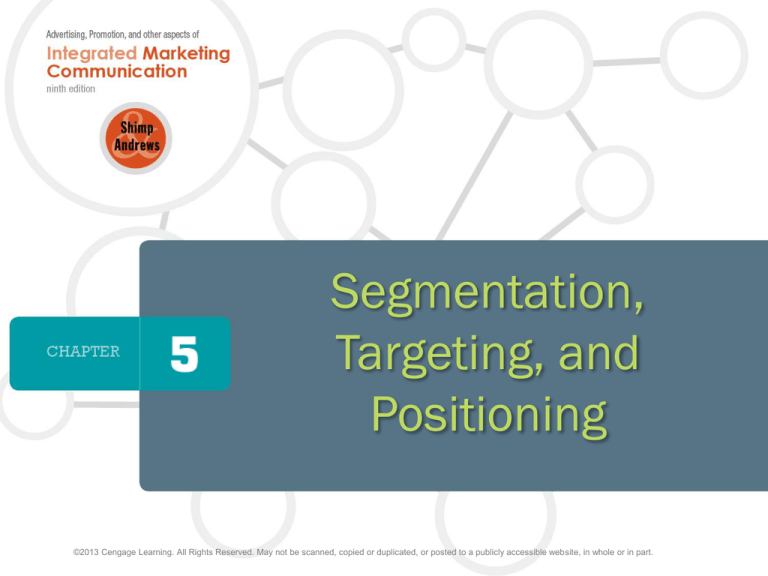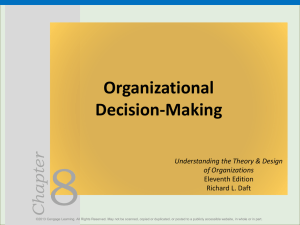
1
Segmentation,
Targeting, and
Positioning
©2013 Cengage Learning. All Rights Reserved. May not be scanned, copied or duplicated, or posted to a publicly accessible website, in whole or in part.
Chapter Objectives
After reading this chapter you should be able to:
1. Appreciate the importance of market segmentation
for specific consumer groups and realize that the
targeting decision is the initial and most
fundamental of all marcom decisions.
2. Understand the role of behavior segmentation in
targeting consumer groups.
3. Describe the nature of psychographic segmentation.
4. Appreciate major demographic developments such
as changes in the age structure of the population
and ethnic population growth.
©2013 Cengage Learning. All Rights Reserved. May not be scanned, copied or duplicated, or posted to a publicly accessible website, in whole or in part.
2
Chapter Objectives (cont’d)
5. Explain the meaning of geodemographics and
understand the role for this form of targeting.
6. Recognize that any single characteristic of
consumers—whether their age, ethnicity, or income
level—likely is not solely sufficient for
sophisticated marcom targeting.
7. Appreciate the concept and practice of brand
positioning.
©2013 Cengage Learning. All Rights Reserved. May not be scanned, copied or duplicated, or posted to a publicly accessible website, in whole or in part.
3
Positioning McDonald’s versus Starbucks
©2013 Cengage Learning. All Rights Reserved. May not be scanned, copied or duplicated, or posted to a publicly accessible website, in whole or in part.
4
Major Steps in the Market Segmentation
Process
Following a consideration of customer needs and benefits sought, the following
are the major steps in the market segmentation process:
• Market segmentation:
• Identify bases (e.g., behavior, demographics) to segment the
market
• Develop profiles of resulting segments
• Market targeting:
• Develop measures of segment attractiveness
• Select the target segment(s)
• Market positioning:
• Develop positioning for each target segment
• Develop marketing mix for each target segment
©2013 Cengage Learning. All Rights Reserved. May not be scanned, copied or duplicated, or posted to a publicly accessible website, in whole or in part.
5
Segmentation Bases
Behavior Segmentation
Psychographics
Measurable Consumer
Characteristics
Demographics
Geodemographics
©2013 Cengage Learning. All Rights Reserved. May not be scanned, copied or duplicated, or posted to a publicly accessible website, in whole or in part.
6
Figure 5.1: Classification of Four General
Targeting Characteristics
©2013 Cengage Learning. All Rights Reserved. May not be scanned, copied or duplicated, or posted to a publicly accessible website, in whole or in part.
7
Behavior Segmentation Issues
• Behavior Segmentation
• Describe how people behave with respect to a particular
product category or class of related products
• Assume that the best predictor of future behavior is past
behavior
• Online Behavioral Targeting
• Tracks the online site-selection behavior of users so as to
enable advertisers to serve targeted ads
• Privacy Concerns
• Technological advances increase the ability to serve
consumers at the risk of invading their privacy
©2013 Cengage Learning. All Rights Reserved. May not be scanned, copied or duplicated, or posted to a publicly accessible website, in whole or in part.
8
Figure 5.2: An Illustration of the Online Ad
Process
©2013 Cengage Learning. All Rights Reserved. May not be scanned, copied or duplicated, or posted to a publicly accessible website, in whole or in part.
9
Psychographic Segmentation
• Psychographics
• Describe aspects of consumers’ psychological
make-ups and lifestyles as they relate to buying
behavior in a particular product category
• Attitudes
• Values
• Motivations
©2013 Cengage Learning. All Rights Reserved. May not be scanned, copied or duplicated, or posted to a publicly accessible website, in whole or in part.
10
Types of Psychographic Profiles
• Customized Psychographic Profiles
• Are typically customized to the client’s specific
product category
• Contain questionnaire items related to the unique
characteristics of the product category
• General Purpose Psychographic Profiles
• Can be purchased as “off-the-shelf” psychographic
data from services that develop psychographic
profiles of people independently of any particular
product or service
©2013 Cengage Learning. All Rights Reserved. May not be scanned, copied or duplicated, or posted to a publicly accessible website, in whole or in part.
11
Illustrative Statements Used In a Customized
Banking-Related Psychographic Study
©2013 Cengage Learning. All Rights Reserved. May not be scanned, copied or duplicated, or posted to a publicly accessible website, in whole or in part.
12
Psychographic Study of Consumers’ Banking
Practices
Psychographic Segments
of Banking Behaviors
Worried
Traditionalists
Bank
Loyalists
Secured
Investors
Thrifty
Bankers
©2013 Cengage Learning. All Rights Reserved. May not be scanned, copied or duplicated, or posted to a publicly accessible website, in whole or in part.
13
MindBase Segments
©2013 Cengage Learning. All Rights Reserved. May not be scanned, copied or duplicated, or posted to a publicly accessible website, in whole or in part.
14
MindBase Segments (Table 15.2 cont’d)
©2013 Cengage Learning. All Rights Reserved. May not be scanned, copied or duplicated, or posted to a publicly accessible website, in whole or in part.
15
Figure 5.2: The 8 VALS Segments
©2013 Cengage Learning. All Rights Reserved. May not be scanned, copied or duplicated, or posted to a publicly accessible website, in whole or in part.
16
VALS Psychographic Segments
Innovators
• Successful, sophisticated, take-charge, with
high self-esteem
Thinkers
• Mature, satisfied, comfortable and reflective;
value order, knowledge, and responsibility,
and motivated by ideals
Believers
• Conservative, conventional with concrete
beliefs based on traditional, established
codes: family, religion, community, and the
nation, motivated by ideals
Achievers
• Motivated by the desire for achievement
have goal-oriented lifestyles and a deep
commitment to career and family
©2013 Cengage Learning. All Rights Reserved. May not be scanned, copied or duplicated, or posted to a publicly accessible website, in whole or in part.
17
VALS Psychographic Segments
Strivers
Experiencers
Makers
Survivors
• Trendy and fun loving, motivated by
achievement out of concern about the
opinions and approval of others
• Motivated by self-expression, young,
enthusiastic, and impulsive consumers;
quickly become enthusiastic about new
possibilities, but are equally quick to cool
• Motivated by self-expression; express
themselves and experience the world by
working on it, and have enough skills and
energy to carry out their projects successfully
• Live narrowly-focused lives with few
resources with which to cope, often believe
the world is changing too quickly, are
comfortable with the familiar, and are
primarily concerned with safety and security
©2013 Cengage Learning. All Rights Reserved. May not be scanned, copied or duplicated, or posted to a publicly accessible website, in whole or in part.
18
Geodemographic Segmentation
• Geodemographics
• Consumers who reside within geographic clusters
such as zip codes or neighborhoods and also share
demographic and lifestyle similarities
• Typical Clusters (PRIZM NE)
• Bohemian Mix
• White Picket Fences
• Suburban Pioneers
©2013 Cengage Learning. All Rights Reserved. May not be scanned, copied or duplicated, or posted to a publicly accessible website, in whole or in part.
19
Demographic Segmentation
Major Demographic
Aspects
Age structure
of the population
Change in
household
composition
Ethnic population
developments
©2013 Cengage Learning. All Rights Reserved. May not be scanned, copied or duplicated, or posted to a publicly accessible website, in whole or in part.
20
Demographic Trends
• World Population Growth
• 6.95 billion (2012) to 8 billion (2025)
to 9.5 billion (2050)
• Changing Age Structure in United States
• Median age will increase to 38 by 2025
• More middle-aged Baby Boomers
• Fewer children, teenagers, and young adults due to
decreased birthrates
©2013 Cengage Learning. All Rights Reserved. May not be scanned, copied or duplicated, or posted to a publicly accessible website, in whole or in part.
21
World’s 25 Largest Countries as of 2011
©2013 Cengage Learning. All Rights Reserved. May not be scanned, copied or duplicated, or posted to a publicly accessible website, in whole or in part.
22
Population of the United States by Age Group,
as of 2010
©2013 Cengage Learning. All Rights Reserved. May not be scanned, copied or duplicated, or posted to a publicly accessible website, in whole or in part.
23
Demographic Segments by Age Group
•
•
•
•
Preschoolers (5 years or younger)
Elementary-school-age children (6-11 years)
Tweens (8-12 years)
Teenagers (13-19 years)
• Millennial Generation or Generation Y
• Highly conformist, narcissistic, and fickle consumers
• Young adults (20-34 years)
• Generation X (Baby Busters)
• Yup & Comers, Bystanders, Playboys, and Drifters
©2013 Cengage Learning. All Rights Reserved. May not be scanned, copied or duplicated, or posted to a publicly accessible website, in whole or in part.
24
Figure 5.4: An Appeal to Preschoolers’
Parents
©2013 Cengage Learning. All Rights Reserved. May not be scanned, copied or duplicated, or posted to a publicly accessible website, in whole or in part.
25
Figure 5.5: An Appeal to Teenagers
©2013 Cengage Learning. All Rights Reserved. May not be scanned, copied or duplicated, or posted to a publicly accessible website, in whole or in part.
26
Demographic Segments: Age
• Middle-Aged (35-54 years)
• Younger baby boomers and older Gen Xers
• Target category for luxury goods and youth
• Mature Consumers (55 years or older)
• Are 25% of the total U.S. population
• Have highest discretionary income and most assets
• Census Bureau classification: Olders (55 to 64); Elders (65
to 74); and the Very Old (75 and over)
• Descriptive groups: Healthy Hermits, Ailing Outgoers, Frail
Recluses, and Healthy Indulgers
©2013 Cengage Learning. All Rights Reserved. May not be scanned, copied or duplicated, or posted to a publicly accessible website, in whole or in part.
27
The Ever-Changing American Household
• Household Defined
• An independent housing entity, either rental
property or owned property.
• U.S. Households
• Growing in number, shrinking in size, and
changing in character.
• Married couples with children younger than 18
now represent less than one-third of all households.
• Single-person and unrelated-person households are
a growing market.
©2013 Cengage Learning. All Rights Reserved. May not be scanned, copied or duplicated, or posted to a publicly accessible website, in whole or in part.
28
Ethnic Population Developments
• Changes in the U.S. Melting Pot
• More diversity in the overall population
• Growth in all ethnic groups
• Implication for Marketers
• Need to devise marcom strategies to meet
ethnic groups’ unique wants/needs
©2013 Cengage Learning. All Rights Reserved. May not be scanned, copied or duplicated, or posted to a publicly accessible website, in whole or in part.
29
Ethnic Groups’ Population Representation
in the United States, 2000–2050 (in millions)
©2013 Cengage Learning. All Rights Reserved. May not be scanned, copied or duplicated, or posted to a publicly accessible website, in whole or in part.
30
Ethnic Population Developments
• African Americans
• Are of an average age that is considerably younger
than that for Caucasians
• Are geographically-concentrated, with threefourths of all African-Americans living in 16 states
• Tend to purchase prestige and name-brand products
in greater proportion than do Caucasians
• Have spending power that totals
nearly $1.1 trillion annually
©2013 Cengage Learning. All Rights Reserved. May not be scanned, copied or duplicated, or posted to a publicly accessible website, in whole or in part.
31
Figure 5.6: African-American Models Appeal
to African American Consumers
©2013 Cengage Learning. All Rights Reserved. May not be scanned, copied or duplicated, or posted to a publicly accessible website, in whole or in part.
32
Ethnic Population Developments (cont’d)
• Hispanic Americans (Latinos)
• Are the largest U.S. minority
population segment
• Are not a single unified market
• Are underserved by current
marketing efforts
• Are responsive to advertising in
their dominant language
©2013 Cengage Learning. All Rights Reserved. May not be scanned, copied or duplicated, or posted to a publicly accessible website, in whole or in part.
33
Top 10 U.S. Hispanic Markets (estimates as of
2010)
©2013 Cengage Learning. All Rights Reserved. May not be scanned, copied or duplicated, or posted to a publicly accessible website, in whole or in part.
34
Ethnic Population Developments (cont’d)
• Asian-Americans
•
•
•
•
•
•
•
•
Represent many nationalities
Are the newest “hot” ethnic market
Are better educated than average
Have higher incomes than average
Occupy more prestigious jobs
Speak a variety of languages
Are heavy users of the Internet
Respond to marketing programs that reflect their values
and lifestyles
©2013 Cengage Learning. All Rights Reserved. May not be scanned, copied or duplicated, or posted to a publicly accessible website, in whole or in part.
35
Market Targeting
The 5 Criteria for Effective Segmentation:
1.
2.
3.
4.
5.
Measurable
Substantial
Accessible
Differentiable
Actionable
Target Market Selection Strategies:
1. Undifferentiated marketing
2. Differentiated marketing
3. Concentrated marketing
©2013 Cengage Learning. All Rights Reserved. May not be scanned, copied or duplicated, or posted to a publicly accessible website, in whole or in part.
36
Figure 5.7: A Framework for Brand Positioning
©2013 Cengage Learning. All Rights Reserved. May not be scanned, copied or duplicated, or posted to a publicly accessible website, in whole or in part.
37
Benefit Positioning
Appealing to
Consumer Needs
Functional
Needs
Symbolic
Needs
Experiential
Needs
©2013 Cengage Learning. All Rights Reserved. May not be scanned, copied or duplicated, or posted to a publicly accessible website, in whole or in part.
38
Categories of Appeals to Consumer Needs
Functional Needs
Symbolic Needs
Experiential
Needs
• Positioning communicates that the brand’s
benefits are capable of solving consumers’
consumption-related problems
• Positioning attempts to associate brand
ownership with a desired group, role, or selfimage
• Positioning promotes brand’s extraordinary
sensory value, or rich potential for cognitive
stimulation
©2013 Cengage Learning. All Rights Reserved. May not be scanned, copied or duplicated, or posted to a publicly accessible website, in whole or in part.
39
Figure 5.8: Croc Advertisement Illustrating
Appeal to Functional Needs
©2013 Cengage Learning. All Rights Reserved. May not be scanned, copied or duplicated, or posted to a publicly accessible website, in whole or in part.
40
Figure 5.9: Dove Advertisement Illustrating
Appeal to Experiential Needs
©2013 Cengage Learning. All Rights Reserved. May not be scanned, copied or duplicated, or posted to a publicly accessible website, in whole or in part.
41
Attribute Positioning
Attribute
Positioning
Product-Related
Non-Product Related:
Usage and User Imagery
©2013 Cengage Learning. All Rights Reserved. May not be scanned, copied or duplicated, or posted to a publicly accessible website, in whole or in part.
42
Figure 5.10: Highlander Advertisement Illustrating
Product-Related Attribute Positioning
©2013 Cengage Learning. All Rights Reserved. May not be scanned, copied or duplicated, or posted to a publicly accessible website, in whole or in part.
43
Figure 5.11: Ralph Lauren Advertisement
Illustrating User Imagery Positioning
©2013 Cengage Learning. All Rights Reserved. May not be scanned, copied or duplicated, or posted to a publicly accessible website, in whole or in part.
44







